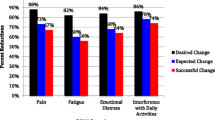Abstract
The purpose of this study was to describe the satisfaction of patients with multiple sclerosis regarding the services they received from their physical and occupational therapists. Eighty-one patients volunteered for the study in response to advertisements and completed the Therapist Evaluation Form (TEF). Subjects had to have been a physical or occupational therapy patient within the last year and also had to have seen the same therapist for a minimum of four treatment visits. Total score and item analysis of the results demonstrated a high degree of satisfaction among the patients surveyed. The content of two open-ended questions on the TEF also showed that patients value therapist characteristics of being friendly and caring. Patients reported less satisfaction with the therapists' technical skills as opposed to rapport issues. These results reinforce the literature, which cites the importance of interpersonal aspects of patient/professional relationships for persons with disabilities. In addition, the initial reliability and validity data on the TEF obtained in this study support its further development as an instrument to measure patient satisfaction in physical and occupational therapy.
Similar content being viewed by others
References
Aminoff, M. J. (1994). Nervous system. In Tierney, L. M., McPhee, S. J., and Papdakis, M. A. (eds.),Current Medical Diagnosis and Treatment. Appleton & Lange, Norwalk, CT, pp. 831–832.
Asch, A., and Rousso, H. (1985). Therapists with disabilities: Theoretical and clinical issues.Psychiatry 48: 1–12.
Carpenter, C. (1994). The experience of spinal cord injury: The individual's perspective-implications for rehabilitation practice.Phys. Ther. 74(7): 614–629.
Cope, D. W., Linn, L. S., Leake, B. D., and Barrett, P. A. (1986). Modification of residents' behavior by preceptor feedback of patient satisfaction.J. Gen. Intern. Med. 1: 394–398.
Davis, C. M. (1989).Patient Practitioner Interaction, Slack, Thorofare, NJ.
DeRogatis, H. (1993). A different reflection.Nurs. Outlook 41: 235–237.
Frankenberg, R. (1988). “Your time or mine” An anthropological view of the tragic temporal contradictions of biomedical practice.Int. J. Health Serv. 18(1): 11–34.
French, S. (1987). Attitudes of physiotherapists to the recruitment of disabled and handicapped people into the physiotherapy profession.Physiotherapy 73(7): 363–367.
Friedman, M. L., and Churchill, G. A. (1987). Using consumer perceptions, and a contingency approach to improve health care delivery.J. Consum. Res. 13: 492–510.
Fryer, J. H., and Cohen, L. (1988). Effects of labeling patients “psychiatric” or “medical”: Favorability of traits ascribed by hospital staff.Psychol. Rep. 62: 779–793.
Gaito, J. (1980). Measurement scales and statistics: Resurgence of an old misconception.Psychol. Bull. 87(3): 564–567.
Guzman, P. M., Sliepcevich, E. M., Lacey, E. P., Vitello, E. M., Matten, M. R., Woehlke, P. L. and Wright, W. R. (1988). Tapping patient satisfaction: A strategy for quality assessment.Pt. Educ. Counsel. 12: 225–233.
Health Services Research Group (1992). A guide to direct measures of patient satisfaction in clinical practice.Can. Med. Assoc. J. 146(10): 1727–1731.
Kerr, N. (1970). Staff expectations for disabled persons: Helpful or harmful?Rehab. Counsel. 14: 85–94.
Linder-Pelz, S. (1982). Toward a theory of patient satisfaction.Soc. Sci. Med. 16: 577–582.
Linn, L. S., Oye, R. K., Cope, D. W., and DiMatteo, M. R. (1986). Use of nonphysician staff to evaluate humanistic behavior of internal medicine residents and faculty members.J. Med. Educ 61: 918–920.
Linn, L. S., Cope, D. W., and Robbins, A. (1987a). Sociodemographic and premedical school factors related to postgraduate physicians' humanistic performance.West. J. Med.147: 99–103.
Linn, L. S., DiMatteo, M. R., Cope, D. W., and Robbins, A. (1987b). Measuring physicians' humanistic attitudes, values and behaviors.Med. Care. 25(6): 504–515.
O'Hare, C., and Tomson, D. (1991). Experiences of physiotherapists, with physical disabilities.Physiotherapy 77(6): 374–378.
Patterson, J. B., and Marks, C. (1992). The client as customer: Achieving service quality and customer satisfaction in rehabilitation.J. Rehab. 58(4): 16–21.
Rabin, D., Rabin, P. L., and Rabin, R. (1982). Compounding the ordeal of ALS: Isolation from my fellow physicians.N. Engl. J. Med. 307(8): 506–509.
Roush, S. E. (1986). Health care professionals as contributors to attitudes toward persons with disabilities—a special communication.Phys. Ther. 66(10): 1551–1554.
Roush, S. E. (1990).Examining the Relationship Between Health Care Professionals and Persons with Disabilities, Doctoral dissertation, University of Washington, Seattle.
Schlenoff, D. (1994). Growing demands on time versus the physician/patient relationship.Md. Family Doc. Summer: 6–10.
Shye, D., Javetz, R., and Shuval, J. T. (1990). Patient initiatives and physician-challenging behaviors: The views of Israeli health professionalsSoc. Sci. Med. 31(7): 719–727.
Speedling, E. J., Morrison, B., Rehr, H., and Rosenberg, G. (1983). Patient satisfaction surveys: Closing the gap between provider and consumer.Qual. Rev. Bull. 9: 224–228.
Stetten, D. (1981). Coping with blindness.N. Engl. J. Med. 305: 458–460.
Sutherland, A. T. (1981).Disabled We Stand, Indiana University Press, Bloomington.
Thacker, K. (1990). Facing the fleshmovers.J. Rehab. 56(1): 8–13.
Tucker, S. J. (1980). The psychology of spinal cord injury: Patient-staff interaction.Rehab. Lit. 41(5–6): 114–121, 160.
Vaughan, C. E. (1993). Origins of conflicting professional and consumer images of blindness.J. Rehab. 59(1): 10–15.
Ware, J. E., and Davies, A. R. (1983). Behavioral consequences of consumer dissatisfaction with medical care.Eval. Prog. Plan. 6: 291–297.
Ware, J. E., Davies-Avery, A., and Stewart, A. L. (1978). The measurement and the meaning of patient satisfaction.Health Med. Care Serv. Rev. 1: 1–15.
Woods, E. (1992). PT confronts physical adversity through professional activism.Progr. Rep. (Amer. Phys. Ther. Assoc.). 21(6): 1–13.
Zimney, L., McClain, M. P., Batalden, P. B., and O'Conner, J. P. (1980). Patient telephone interviews: A valuable technique for finding problems and assessing quality in ambulatory medical care.J. Commun. Health 6(1): 35–42.
Author information
Authors and Affiliations
Rights and permissions
About this article
Cite this article
Roush, S.E. The satisfaction of patients with multiple sclerosis regarding services received from physical and occupational therapists. Int J Rehab Health 1, 155–166 (1995). https://doi.org/10.1007/BF02214728
Issue Date:
DOI: https://doi.org/10.1007/BF02214728




